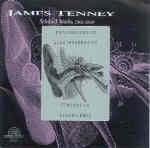More than a few generations of composers bitten by the experimental bug while doing serious university time consider James Tenney’s electronic and tape pieces from the 1960s a kind of Rosetta Stone. Some highly esteem Tenney as a theorist and all-around idea man. Since the theoretical, mechanical, and aesthetic processes governing the eight works included on this release are thoroughly dealt with in the booklet notes, it’s best to discuss the purely musical results. In Collage #1 (1961), low-pitched groans and high-pitched organ-like bleats butt heads and run around in circles, interrupted by cut-up fragments of Elvis Presley singing “Blue Suede Shoes” that probably sounded more daring in 1961 than in today’s sample-driven D.J. set environment. Dialogue (1963) begins with unpitched filters and envelopes expanding electronic air, becoming interesting once aggregates of pointilistic, woodwind-like pitches kick in like a visit from Milton Babbitt.
Long, sustained tones either introduced or buttoned by friskier flourishes define the rather static and two-dimensional contours of Phases (1963). Music for Player Piano (1963-64) flirts between scurrying, clotted chords, strategically ringing single notes, and silences. After a minute or so the textures start to grow predictable, which never was the case with Conlon Nancarrow’s far more inventive Studies for Player Piano. Sitting through all 18 and a half minutes of Ergodos II (a 1964 piece for John Cage) is not unlike twiddling a shortwave radio dial, waiting for something to happen.
Something does happen, however, in Fabric for Ché (1967), where four minutes and 25 seconds of relentlessly loud, ugly sounds resembling industrial clatter, buzzsaws, and five Concordes taking off are then played in reverse. Or should we say retrograde? For Ann (rising), a composition from 1969, at first appears to be nothing more than slowly rising tones that never end. As certain tones disappear, others are added to the mix in a way that you don’t notice their first appearance, nor that some tones are ascending at a faster rate than others. Patient listening yields subtle harmonic shifts and gentle overtone collisions. I can’t pretend to love most of what’s on this disc, but I acknowledge its seriousness and rigor. All the selections, by the way, were painstakingly remastered from the best existing source material.
































